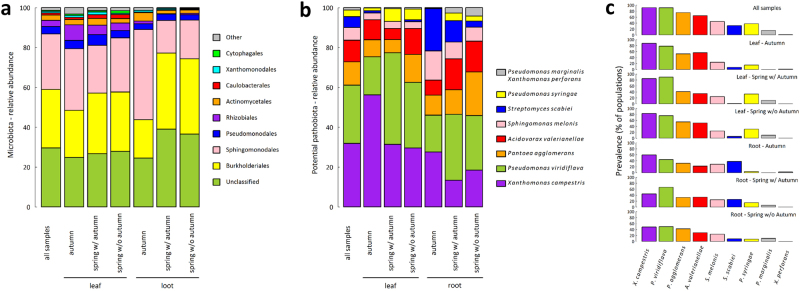Fig. 2.
Stacked barplots of the relative abundances of the major bacterial orders and bacterial species for microbiota and potential pathobiota of the A. thaliana populations collected in the Midi-Pyrénées region, respectively. a Stacked barplots representing the relative abundance for the ten most abundant bacterial orders of the microbiota. “All samples” n = 1655; leaf: “autumn” n = 314, “spring w/ autumn” n = 245, “spring wo/ autumn” n = 262; root: “autumn” n = 309, “spring w/ autumn” n = 267, “spring wo/ autumn” n = 258. In comparison with autumn, samples in spring were enriched for Burkholderiales (χ2 = 7.93, P < 0.01) and depleted for Sphingomonodales (χ2 = 18.18, P < 0.001) but only in the root compartment. b Stacked barplots representing the relative abundance of the nine bacterial species representing the potential pathobiota. “All samples” n = 1203; leaf: “autumn” n = 273, “spring w/ autumn” n = 209, “spring wo/ autumn” n = 213; root: “autumn” n = 180, “spring w/ autumn” n = 171, “spring wo/ autumn” n = 157. For the seasonal groups “autumn” and “spring w/autumn,” we observed a depletion of X. campestris (“autumn,” χ2 = 15.67, P < 0.01; “spring with autumn,” χ2 = 8.26, P < 0.05) and an enrichment of S. scabiei (“autumn,” χ2 = 18.61 P < 0.001; “spring with autumn,” χ2 = 9.31, P < 0.05) in the root compartment in comparison with the leaf compartment. In the leaf compartment, an enrichment of P. viridiflava between autumn and spring (χ2 = 15.20, P < 0.01) was associated with a depletion of X. campestris (χ2 = 11.50, P < 0.01). A correction for the number of tests was performed to control the false discovery rate at a nominal level of 5%. c Prevalence (number of populations in which the potential pathogen species was detected) of the nine bacterial species characterizing the potential pathobiota

